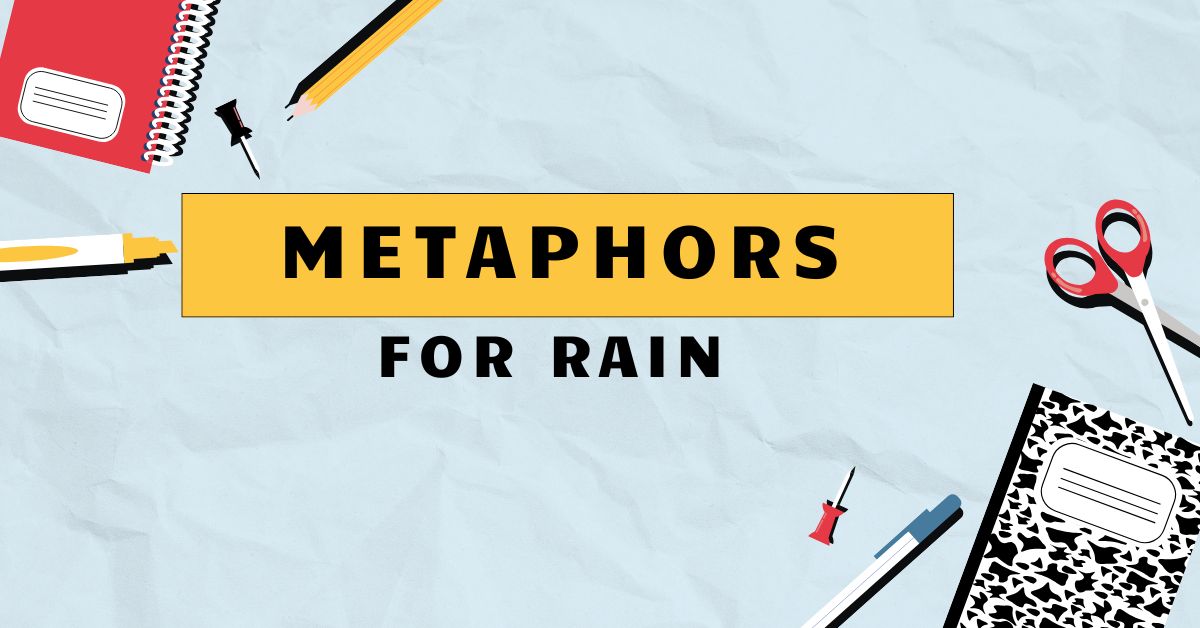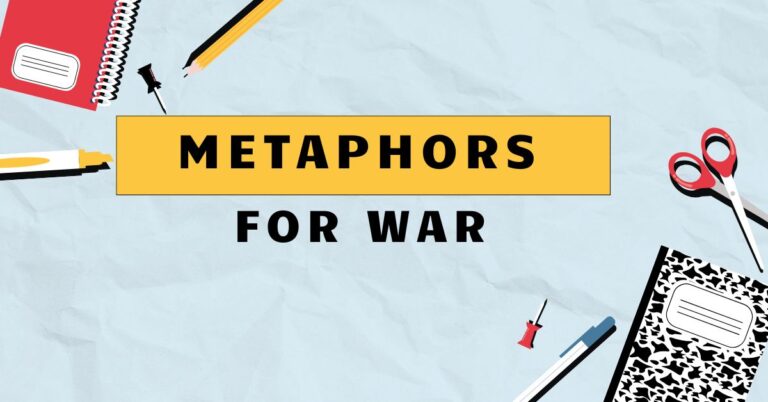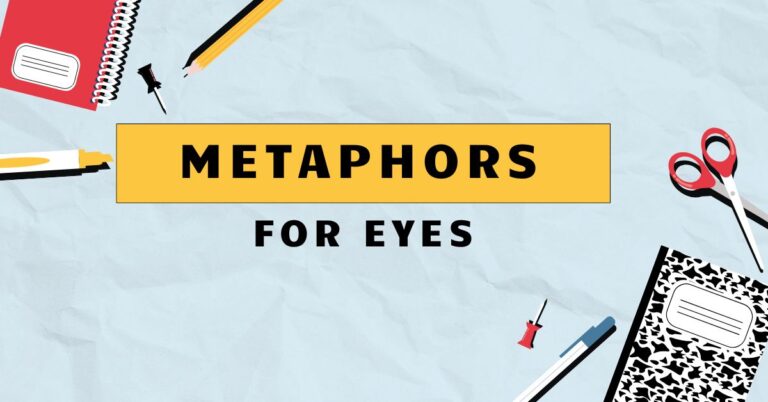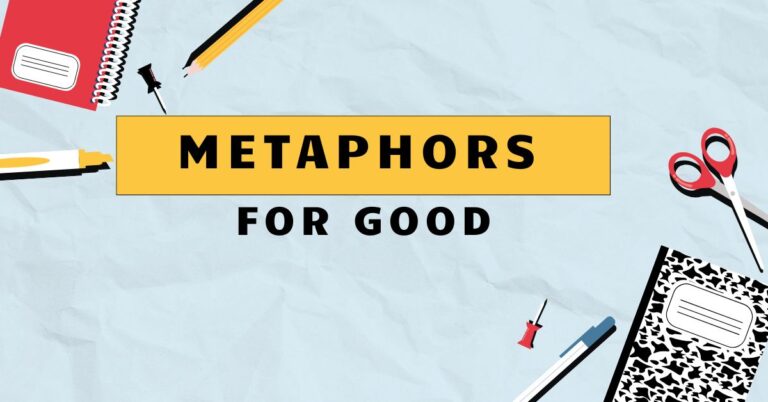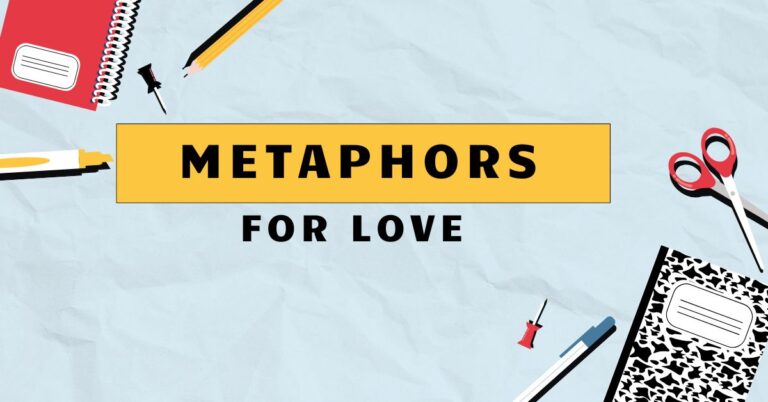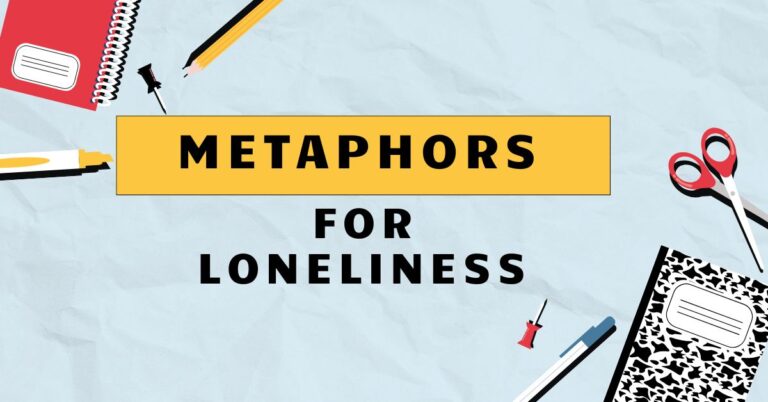45 Metaphors for Rain: Understanding Figurative Language
Metaphors bring color and depth to our language, transforming ordinary descriptions into vivid imagery. Understanding metaphors for rain enhances our appreciation of figurative language and improves our ability to communicate effectively.
This article explores the various types of metaphors used to describe rain, providing examples, usage rules, and practice exercises. This comprehensive guide is perfect for English language learners, writers, and anyone interested in enriching their vocabulary and expressive skills.
Table of Contents
- Introduction
- Definition of Metaphor for Rain
- Structural Breakdown of Rain Metaphors
- Types and Categories of Rain Metaphors
- Examples of Metaphors for Rain
- Usage Rules for Rain Metaphors
- Common Mistakes with Rain Metaphors
- Practice Exercises
- Advanced Topics in Rain Metaphors
- FAQ
- Conclusion
Definition of Metaphor for Rain
A metaphor for rain is a figure of speech that describes rain by comparing it to something else, without using “like” or “as.” This comparison is not literal but symbolic, aiming to create a more vivid or evocative image in the reader’s or listener’s mind. Metaphors help us understand and relate to rain in new and imaginative ways.
The function of a rain metaphor is to go beyond a simple description of precipitation. It adds layers of meaning, emotion, and sensory detail.
By associating rain with other concepts or objects, we can convey its intensity, beauty, or impact more effectively. For example, instead of saying “it’s raining heavily,” one might say “the sky is weeping,” which evokes a sense of sadness or cleansing.
Rain metaphors are used in various contexts, including literature, poetry, songwriting, and everyday conversation. They are particularly common in creative writing, where authors seek to create atmosphere and convey emotions through vivid imagery.
Understanding and using rain metaphors can greatly enhance one’s writing and communication skills.
Structural Breakdown of Rain Metaphors
The basic structure of a rain metaphor involves two key elements: thetenorand thevehicle. The tenor is the subject being described (in this case, rain), and the vehicle is the object or concept to which it is being compared.
The connection between the tenor and the vehicle is what creates the metaphorical meaning.
For example, in the metaphor “the rain is a curtain,” the tenor is “rain,” and the vehicle is “curtain.” The shared characteristic is the way both rain and a curtain can obscure or cover something. The effectiveness of the metaphor depends on how well the vehicle conveys the intended meaning or feeling about the rain.
Effective rain metaphors often rely on sensory details to create a strong image. They might appeal to sight (e.g., “the rain is a silver sheet”), sound (e.g., “the rain is a drumbeat”), or touch (e.g., “the rain is a cold kiss”).
By engaging the senses, these metaphors can create a more immersive and impactful experience for the audience.
Types and Categories of Rain Metaphors
Rain metaphors can be categorized based on the types of comparisons they make. Here are some common categories:
Personification
Personification gives human qualities to rain. This is a very common and effective type of rain metaphor.
Examples include: “The rain whispers secrets,” “The rain dances on the roof,” or “The rain cries.” These metaphors imbue rain with human actions or emotions, making it more relatable and expressive.
Animalistic Metaphors
Animalistic metaphors compare rain to animals or their behavior. This can suggest both the intensity and the natural, untamed aspects of rain.
Examples include: “The rain is a lion roaring,” “The rain is a swarm of bees,” or “The rain is a hissing snake.” These comparisons can convey the power, chaos, or danger associated with heavy rainfall.
Emotional Metaphors
Emotional metaphors connect rain to human emotions, such as sadness, joy, or peace. This type of metaphor can evoke a strong emotional response in the reader.
Examples include: “The rain is sorrow falling from the sky,” “The rain is tears of joy,” or “The rain is a lullaby of peace.” These metaphors create a direct link between the weather and the human emotional experience.
Destructive Metaphors
Destructive metaphors emphasize the damaging or overwhelming aspects of heavy rain. This can be used to highlight the potential dangers of severe weather.
Examples include: “The rain is a flood of destruction,” “The rain is a hammer against the city,” or “The rain is an angry god.” These metaphors convey the force and potential harm of intense rainfall.
Cleansing Metaphors
Cleansing metaphors portray rain as a purifying or refreshing force. This type of metaphor highlights the positive effects of rain on the environment and the human spirit.
Examples include: “The rain is a cleansing bath for the earth,” “The rain washes away the pain,” or “The rain is a fresh start.” These metaphors emphasize the renewal and revitalization that rain can bring.
Examples of Metaphors for Rain
Here are several examples of metaphors for rain, categorized by their type, to further illustrate their usage and impact.
The following table showcases examples of personification metaphors for rain, attributing human-like qualities and actions to it.
| Category | Metaphor | Explanation |
|---|---|---|
| Personification | The rain is weeping over the city. | Rain is given the human emotion of sadness, suggesting a somber atmosphere. |
| Personification | The rain whispered secrets to the trees. | Rain is described as whispering, implying a gentle, secretive sound. |
| Personification | The rain danced on the tin roof. | Rain is given the action of dancing, suggesting a lively and rhythmic sound. |
| Personification | The rain kissed the parched earth. | Rain is described as kissing, implying a gentle and nurturing touch. |
| Personification | The rain scolded the dry flowers. | Rain is given the action of scolding, suggesting a harsh or corrective effect. |
| Personification | The rain sighed as it fell. | Rain is given the action of sighing, suggesting a relief or exhaustion. |
| Personification | The rain complained with thunderous voice. | Rain is given the action of complaining, suggesting anger. |
| Personification | The rain giggled as it splashed in puddles. | Rain is given the action of giggling, suggesting amusement. |
| Personification | The rain plotted against the picnic. | Rain is given the action of plotting, suggesting a malicious intent. |
| Personification | The rain gossiped amongst the clouds. | Rain is given the action of gossiping, suggesting a playful commotion. |
| Personification | The rain argued with the wind. | Rain is given the action of arguing, suggesting a clash and a struggle. |
| Personification | The rain lectured the thirsty ground. | Rain is given the action of lecturing, suggesting a commanding presence. |
| Personification | The rain envied the sun’s warmth. | Rain is given the emotion of envy. |
| Personification | The rain regretted its cold touch. | Rain is given the emotion of regret. |
| Personification | The rain dreamed of sunny days. | Rain is given the action of dreaming. |
| Personification | The rain sulked behind the clouds. | Rain is given the emotion of sulking. |
| Personification | The rain apologized with a rainbow. | Rain is given the act of apologizing. |
| Personification | The rain boasted its power with lightning. | Rain is given the act of boasting. |
| Personification | The rain remembered the drought with sorrow. | Rain is given the act of remembering with sorrow. |
| Personification | The rain hoped for a gentle breeze. | Rain is given the act of hoping. |
| Personification | The rain taught the rivers to flow. | Rain is given the action of teaching. |
| Personification | The rain judged the dry fields. | Rain is given the action of judging. |
| Personification | The rain applauded the blooming flowers. | Rain is given the action of applauding. |
| Personification | The rain yearned for the sea. | Rain is given the emotion of yearning. |
| Personification | The rain laughed with thunder. | Rain is given the action of laughing. |
| Personification | The rain worried about the harvest. | Rain is given the emotion of worrying. |
| Personification | The rain plotted against the sun. | Rain is given the action of plotting. |
| Personification | The rain advised the crops to grow. | Rain is given the action of advising. |
The following table illustrates animalistic metaphors for rain, comparing it to various animals or their behaviors to emphasize certain qualities.
| Category | Metaphor | Explanation |
|---|---|---|
| Animalistic | The rain is a cat scratching at the window. | Rain is compared to a cat, suggesting a light, persistent, and slightly irritating sound. |
| Animalistic | The rain is a herd of elephants stampeding across the plains. | Rain is compared to a herd of elephants, suggesting a powerful and overwhelming force. |
| Animalistic | The rain is a swarm of bees buzzing around the flowers. | Rain is compared to a swarm of bees, suggesting a busy, constant, and pervasive presence. |
| Animalistic | The rain is a pack of wolves howling at the moon. | Rain is compared to a pack of wolves, suggesting a wild, mournful, and intense sound. |
| Animalistic | The rain is a flock of birds pecking at the ground. | Rain is compared to a flock of birds, suggesting a gentle, scattered, and repetitive action. |
| Animalistic | The rain is a snake slithering down the mountain. | Rain is compared to a snake, suggesting a smooth, continuous, and potentially dangerous flow. |
| Animalistic | The rain is a bear growling in the forest. | Rain is compared to a bear, suggesting a deep, threatening, and powerful presence. |
| Animalistic | The rain is a butterfly fluttering through the meadow. | Rain is compared to a butterfly, suggesting a delicate, light, and ephemeral touch. |
| Animalistic | The rain is a spider weaving its web. | Rain is compared to a spider, suggesting a intricate, pervasive, and encompassing presence. |
| Animalistic | The rain is a lion roaring in the savanna. | Rain is compared to a lion, suggesting a powerful, dominant, and assertive force. |
| Animalistic | The rain is a cricket chirping in the night. | Rain is compared to a cricket, suggesting a quiet, persistent, and rhythmic sound. |
| Animalistic | The rain is an eagle soaring above the clouds. | Rain is compared to an eagle, suggesting a high, majestic, and commanding presence. |
| Animalistic | The rain is a fox hunting in the woods. | Rain is compared to a fox, suggesting a stealthy, pervasive, and determined action. |
| Animalistic | The rain is a whale spouting in the ocean. | Rain is compared to a whale, suggesting a massive, powerful, and impactful event. |
| Animalistic | The rain is a dolphin playing in the waves. | Rain is compared to a dolphin, suggesting a playful, energetic, and joyful presence. |
| Animalistic | The rain is a squirrel gathering nuts. | Rain is compared to a squirrel, suggesting a busy, persistent, and resourceful action. |
| Animalistic | The rain is a turtle crawling on the beach. | Rain is compared to a turtle, suggesting a slow, steady, and persistent pace. |
| Animalistic | The rain is a hummingbird sipping nectar. | Rain is compared to a hummingbird, suggesting a delicate, quick, and precise action. |
| Animalistic | The rain is a swan gliding on the lake. | Rain is compared to a swan, suggesting a graceful, smooth, and elegant movement. |
| Animalistic | The rain is a mosquito buzzing in your ear. | Rain is compared to a mosquito, suggesting an annoying, persistent, and irritating presence. |
| Animalistic | The rain is a hawk circling overhead. | Rain is compared to a hawk, suggesting a watchful, patient, and observant presence. |
| Animalistic | The rain is a frog croaking in the pond. | Rain is compared to a frog, suggesting a wet, repetitive, and natural sound. |
| Animalistic | The rain is a seagull crying by the sea. | Rain is compared to a seagull, suggesting a mournful, wild, and coastal sound. |
| Animalistic | The rain is a penguin waddling on the ice. | Rain is compared to a penguin, suggesting a clumsy, persistent, and cold presence. |
| Animalistic | The rain is a jellyfish floating in the ocean. | Rain is compared to a jellyfish, suggesting a gentle, drifting, and pervasive presence. |
| Animalistic | The rain is a starfish clinging to the rock. | Rain is compared to a starfish, suggesting a persistent, clinging, and natural presence. |
| Animalistic | The rain is a seahorse swimming in the reef. | Rain is compared to a seahorse, suggesting a delicate, gentle, and underwater movement. |
The following table presents examples of emotional metaphors for rain, linking it to various human emotions and feelings.
| Category | Metaphor | Explanation |
|---|---|---|
| Emotional | The rain is a blanket of sorrow. | Rain is compared to sorrow, suggesting a heavy, enveloping feeling of sadness. |
| Emotional | The rain is tears of the sky. | Rain is compared to tears, suggesting sadness or mourning. |
| Emotional | The rain is a lullaby of peace. | Rain is compared to a lullaby, suggesting calmness and tranquility. |
| Emotional | The rain is anger unleashed. | Rain is compared to anger, suggesting a violent and destructive force. |
| Emotional | The rain is a fresh start. | Rain is compared to a fresh start, suggesting renewal and hope. |
| Emotional | The rain is a cloak of melancholy. | Rain is compared to melancholy, suggesting a heavy and pervasive sadness. |
| Emotional | The rain is a wave of nostalgia. | Rain is compared to nostalgia, suggesting a longing for the past. |
| Emotional | The rain is a whisper of regret. | Rain is compared to regret, suggesting a quiet and lingering sadness. |
| Emotional | The rain is a sigh of relief. | Rain is compared to relief, suggesting a release of tension. |
| Emotional | The rain is a dance of joy. | Rain is compared to joy, suggesting a lively and celebratory mood. |
| Emotional | The rain is a song of longing. | Rain is compared to longing, suggesting a deep and persistent desire. |
| Emotional | The rain is a story of resilience. | Rain is compared to resilience, suggesting strength and recovery. |
| Emotional | The rain is a balm of comfort. | Rain is compared to comfort, suggesting soothing and healing qualities. |
| Emotional | The rain is a mirror of reflection. | Rain is compared to reflection, suggesting introspection and contemplation. |
| Emotional | The rain is a veil of mystery. | Rain is compared to mystery, suggesting intrigue and obscurity. |
| Emotional | The rain is a flame of passion. | Rain is compared to passion, suggesting intensity and fervor. |
| Emotional | The rain is a shadow of fear. | Rain is compared to fear, suggesting anxiety and apprehension. |
| Emotional | The rain is a spark of inspiration. | Rain is compared to inspiration, suggesting creativity and motivation. |
| Emotional | The rain is a breath of freedom. | Rain is compared to freedom, suggesting liberation and release. |
| Emotional | The rain is a heart of compassion. | Rain is compared to compassion, suggesting empathy and kindness. |
| Emotional | The rain is a hand of forgiveness. | Rain is compared to forgiveness, suggesting reconciliation and release. |
| Emotional | The rain is a voice of wisdom. | Rain is compared to wisdom, suggesting knowledge and understanding. |
| Emotional | The rain is a shield of protection. | Rain is compared to protection, suggesting safety and security. |
| Emotional | The rain is a bridge of connection. | Rain is compared to connection, suggesting unity and understanding. |
| Emotional | The rain is a light of hope. | Rain is compared to hope, suggesting optimism and expectation. |
| Emotional | The rain is a tapestry of memories. | Rain is compared to memories, suggesting reflection and reminiscence. |
| Emotional | The rain is a garden of dreams. | Rain is compared to dreams, suggesting imagination and aspiration. |
Usage Rules for Rain Metaphors
When using metaphors for rain, it’s important to follow certain guidelines to ensure clarity and effectiveness:
- Choose appropriate vehicles: The object or concept you compare rain to should be relevant and meaningful. The connection between the rain and the vehicle should be clear and logical.
- Consider the context: The context in which you use the metaphor will influence its interpretation. Be mindful of the tone and purpose of your writing or speech.
- Avoid clichés: Overused metaphors can lose their impact. Try to create fresh and original comparisons that will capture the reader’s attention.
- Maintain consistency: Once you establish a metaphor, stick with it throughout the passage. Mixing metaphors can create confusion and weaken your writing.
- Be mindful of cultural differences: Some metaphors may have different meanings or connotations in different cultures. Be aware of your audience and choose metaphors that will be universally understood.
Common Mistakes with Rain Metaphors
Here are some common mistakes to avoid when using metaphors for rain:
| Mistake | Incorrect Example | Correct Example | Explanation |
|---|---|---|---|
| Mixing metaphors | The rain is a weeping curtain of joy. | The rain is a weeping curtain. / The rain is tears of joy. | Mixing “weeping curtain” (sadness) with “joy” creates a contradictory image. |
| Using clichés | The rain is a pain. | The rain is a relentless drumbeat. | “The rain is a pain” is overused and lacks originality. |
| Inappropriate vehicle | The rain is a refrigerator. | The rain is a cold blanket. | A refrigerator has no clear connection to rain, while a cold blanket evokes a sense of chill. |
| Lack of clarity | The rain is a thing. | The rain is a river flowing from the sky. | “A thing” is too vague. A river provides a clearer image of flowing water. |
Practice Exercises
Test your understanding of metaphors for rain with these exercises:
Exercise 1: Identify the Metaphor
Identify the metaphor in each sentence and explain its meaning.
| Question | Answer |
|---|---|
| 1. The rain is a silver screen blurring the city lights. | Metaphor: “Silver screen.” Meaning: Rain is compared to a movie screen, emphasizing its visual effect of obscuring and softening the city lights. |
| 2. The rain is a gardener watering the thirsty plants. | Metaphor: “Gardener.” Meaning: Rain is compared to a gardener, highlighting its nurturing and life-giving role for plants. |
| 3. The rain is a symphony of droplets on the roof. | Metaphor: “Symphony.” Meaning: Rain is compared to a musical composition, emphasizing the harmonious and rhythmic sounds it creates. |
| 4. The rain is a sculptor carving the landscape. | Metaphor: “Sculptor.” Meaning: Rain is compared to a sculptor, highlighting its ability to shape and transform the earth over time. |
| 5. The rain is a messenger delivering news from the clouds. | Metaphor: “Messenger.” Meaning: Rain is compared to a messenger, suggesting that it brings important information or changes from the sky. |
| 6. The rain is a painter coloring the world in shades of gray. | Metaphor: “Painter.” Meaning: Rain is compared to a painter, emphasizing its ability to transform the visual appearance of the world. |
| 7. The rain is a dancer twirling in the wind. | Metaphor: “Dancer.” Meaning: Rain is compared to a dancer, highlighting its graceful and dynamic movement. |
| 8. The rain is a healer soothing the parched earth. | Metaphor: “Healer.” Meaning: Rain is compared to a healer, emphasizing its ability to restore and revitalize dry land. |
| 9. The rain is a composer writing a song of the storm. | Metaphor: “Composer.” Meaning: Rain is compared to a composer, highlighting its role in creating the dramatic and powerful sounds of a storm. |
| 10. The rain is a storyteller narrating tales of the sky. | Metaphor: “Storyteller.” Meaning: Rain is compared to a storyteller, suggesting that it conveys narratives and experiences from the atmosphere. |
Exercise 2: Create Your Own Metaphors
Create a metaphor for rain using each of the following categories:
| Category | Your Metaphor |
|---|---|
| Personification | The rain is crying softly in the night. |
| Animalistic | The rain is a squirrel chattering on the roof. |
| Emotional | The rain is a moment of peace. |
| Destructive | The rain is a flood of despair. |
| Cleansing | The rain is a baptism of the earth. |
| Descriptive | The rain is a curtain of diamonds. |
| Auditory | The rain is a drum solo on the windowpane. |
| Tactile | The rain is a cold embrace. |
| Gustatory | The rain is a sip of refreshment. |
| Olfactory | The rain is a perfume of petrichor. |
Exercise 3: Correct the Mistakes
Identify and correct the mistakes in the following metaphors:
| Question | Corrected Metaphor |
|---|---|
| 1. The rain is a happy sadness. | The rain is a bittersweet memory. |
| 2. The rain is a shoe. | The rain is a cold shower. |
| 3. The rain is a weeping party. | The rain is a weeping sky. |
| 4. The rain is like a hammer and a feather. | The rain is a hammer. / The rain is a feather. |
| 5. The rain is a hot ice cube. | The rain is a chilling mist. |
| 6. The rain is a jumping sleep. | The rain is a restless dream. |
| 7. The rain is a silent scream. | The rain is a hushed lament. |
| 8. The rain is a heavy light. | The rain is a dim glow. |
| 9. The rain is a dry flood. | The rain is a torrent of tears. |
| 10. The rain is a square circle. | The rain is an endless cycle. |
Advanced Topics in Rain Metaphors
For advanced learners, exploring the use of extended metaphors and symbolism in relation to rain can offer deeper insights. An extended metaphor is a metaphor that is developed over several lines or even an entire piece of writing.
This allows for a more complex and nuanced comparison between the rain and the chosen vehicle.
Symbolism, on the other hand, involves using rain to represent broader themes or ideas, such as cleansing, renewal, or sadness. For example, rain might symbolize the washing away of past mistakes or the beginning of a new chapter in life.
Understanding these advanced techniques can elevate your writing and communication to a higher level.
Analyzing how famous authors and poets have used rain metaphors can also be highly beneficial. Examining works by writers such as T.S.
Eliot, Emily Dickinson, and Langston Hughes can provide valuable insights into the creative and artistic potential of rain metaphors.
FAQ
Here are some frequently asked questions about metaphors for rain:
- What is the difference between a metaphor and a simile?
A metaphor compares two things directly, without using “like” or “as” (e.g., “The rain is tears”). A simile compares two things using “like” or “as” (e.g., “The rain is like tears”).
- Why are metaphors important in writing?
Metaphors add depth, color, and emotion to writing. They help readers understand and connect with the subject matter on a deeper level by creating vivid images and associations.
- How can I create effective rain metaphors?
To create effective rain metaphors, choose vehicles that have clear and meaningful connections to rain. Consider the context, avoid clichés, and be mindful of cultural differences.
- What are some common themes associated with rain metaphors?
Common themes include cleansing, renewal, sadness, destruction, and peace. The specific theme will depend on the chosen vehicle and the intended message.
- Can rain metaphors be used in everyday conversation?
Yes, rain metaphors can be used in everyday conversation to add color and expressiveness to your language. However, it’s important to use them appropriately and avoid being overly dramatic or confusing.
- How do I avoid mixing metaphors?
To avoid mixing metaphors, stick with a single comparison throughout a passage. If you want to introduce a new idea, start a new metaphor rather than combining unrelated images.
- What role does imagery play in rain metaphors?
Imagery is crucial in rain metaphors because it helps create a sensory experience for the reader. By appealing to sight, sound, touch, and emotion, metaphors can make the description of rain more vivid and impactful.
- How can I improve my understanding of rain metaphors?
To improve your understanding, read widely and pay attention to how authors and poets use metaphors. Practice creating your own metaphors and seek feedback from others.
- Are there any cultural differences in the interpretation of rain metaphors?
Yes, different cultures may have different associations with rain. For example, in some cultures, rain is seen as a blessing, while in others, it may be associated with hardship or sorrow. Be mindful of these differences when using rain metaphors.
- What is the difference between a dead metaphor and a fresh metaphor?
A dead metaphor is one that has become so overused that it has lost its original metaphorical meaning and is now used as a literal expression (e.g., “falling in love”). A fresh metaphor is a new and original comparison that creates a vivid and impactful image.
- Can metaphors be combined with other figures of speech?
Yes, metaphors can be combined with other figures of speech, such as personification, hyperbole, and irony, to create even more complex and nuanced effects. This can add layers of meaning and enhance the overall impact of your writing.
Conclusion
Metaphors for rain offer a powerful way to enrich our language and enhance our understanding of the natural world. By comparing rain to other objects, concepts, and emotions, we can create vivid images and convey complex ideas in a more engaging and memorable way.
Understanding the different types of rain metaphors, following usage rules, and avoiding common mistakes are key to mastering this aspect of figurative language.
Continue to practice creating and analyzing rain metaphors to further develop your skills. Pay attention to how metaphors are used in literature, poetry, and everyday conversation.
By doing so, you can unlock the full potential of this expressive tool and elevate your writing and communication to new heights. Remember, the key to effective metaphors is to be creative, thoughtful, and mindful of the context and audience.

